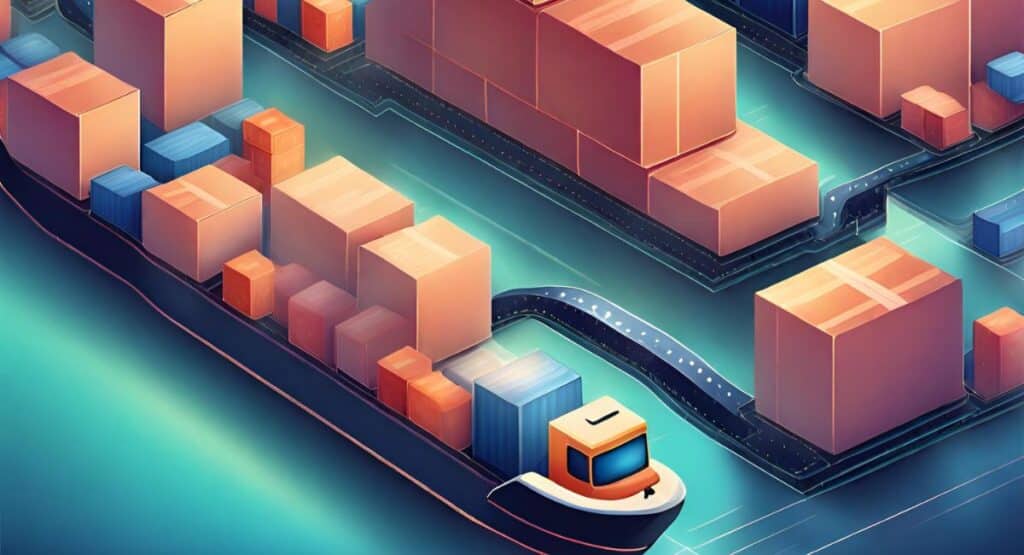In the dynamic landscape of the global supply chain industry, it has become increasingly crucial for businesses to optimize their supply chain visibility, management, and logistics. With rising energy prices, evolving customer demands, and growing complexities, companies must adapt to stay competitive and efficient.
In Singapore, a thriving hub for logistics and trade, the need for enhanced supply chain visibility is paramount. By leveraging advanced technologies and data-driven analytics, businesses can optimize their logistics operations and drive growth. With Singapore’s strategic location, world-class infrastructure, and business-friendly environment, it provides the ideal setting for companies to enhance their supply chain visibility.
In this article, we will explore the challenges faced by the global supply chain industry, the opportunities that Singapore offers as a regional leader in supply chain coordination, and the importance of technology-driven solutions in achieving visibility and resilience. We will also discuss the benefits of establishing a centralized supply chain platform for information sharing, harmonizing standards, and the role of industry collaboration in driving innovation and enhancing supply chain visibility.
Join us as we uncover the strategies and best practices needed to enhance your supply chain visibility in Singapore, and equip your business with the tools to navigate the complexities of the modern supply chain industry.
Key Takeaways
|
Table of Content:
Table of Content

The Challenges of Fragmentation in the Supply Chain Industry
The supply chain industry faces a multitude of challenges due to its significant fragmentation. This fragmentation leads to varying levels of supply chain maturity and logistical infrastructure among countries. Consequently, there are deviations in terminal productivity, container traffic waiting time, and technology usage, hindering diversification efforts and limiting overall success.
Countries, including Singapore, grapple with securing their supply chains amidst geopolitical conflicts, inflationary pressures, and climate change events. These factors further amplify the supply chain complexity and increase the need for robust solutions to overcome logistical hurdles.
Impacts of Fragmentation
The fragmented nature of the supply chain industry poses various challenges that impede smooth operations and hinder efficient logistics management. One significant impact is the inconsistent levels of logistical infrastructure among countries. This inconsistency affects the overall performance of the supply chain, including terminal operations, transportation efficiency, and warehousing capabilities.
Additionally, supply chain complexity arising from fragmentation leads to difficulties in coordinating logistics providers across different regions. The lack of standardized processes and communication protocols limits the ability to streamline operations and optimize resources effectively. As a result, organizations often face delays in shipments, increased costs, and decreased customer satisfaction.
Furthermore, fragmented supply chains are less resilient to disruptions. Supply chain risks such as natural disasters, political instability, and economic uncertainties are more difficult to mitigate when there is a lack of interconnectedness and collaboration among supply chain partners. This vulnerability leaves businesses susceptible to significant disruptions, leading to decreased productivity and compromised customer confidence.
To overcome these challenges, the industry must recognize the importance of supply chain visibility and invest in initiatives that promote collaboration, standardization, and the development of robust logistical infrastructure.
Singapore’s Opportunity to Lead Supply Chain Coordination in the Region
Supply chain fragmentation offers Singapore a chance to lead coordination efforts in Southeast Asia. Singapore’s strong legal framework and advanced regional technologies can create a centralized, collaborative supply chain platform. This model will enhance coordination, build regional resilience, and foster innovation in technology and ESG.
Singapore’s strategic location and infrastructure position it to lead these efforts. A shared model can unify regional expertise and resources, optimizing supply chain performance and efficiency. It will enable seamless information sharing, streamlined processes, and improved visibility.
This collaboration boosts regional resilience by allowing countries to build strategic stockpiles, efficiently distribute resources, and respond effectively to challenges like natural disasters and geopolitical issues. It ensures business continuity and minimizes disruptions across the supply chain.
Additionally, this model drives innovation by leveraging technologies like AI, IoT, and blockchain. These advancements support digital transformation and sustainable practices, aligning with the region’s goals to become a tech hub and promote ESG initiatives.
In conclusion, Singapore can lead regional supply chain coordination by establishing a centralized, collaborative platform. This will enhance management, build resilience, and drive innovation, unlocking the full potential of Southeast Asia’s supply chain ecosystem.
Embracing Technology for Supply Chain Visibility and Resilience
Technology plays a crucial role in enhancing supply chain adaptability and resilience. By embracing emerging technologies such as AI-driven analytics, advanced network optimization, digital twin control towers, and cognitive decision centers, companies can improve supply chain visibility.
These technologies enable real-time data analysis, predictive modeling, and intelligent decision-making, empowering companies to gain valuable insights into their supply chains.
AI-driven analytics leverages machine learning algorithms to analyze vast amounts of data, enabling companies to identify patterns, trends, and potential supply chain disruptions. This enables proactive planning and risk management, helping companies optimize their operations and mitigate potential bottlenecks.
Network optimization plays a crucial role in optimizing supply chain efficiency. By leveraging advanced algorithms and optimization techniques, companies can streamline their network design, transportation routes, and inventory management. This results in reduced lead times, improved resource allocation, and enhanced customer satisfaction.
Digital twin control towers provide a virtual representation of the physical supply chain, allowing companies to monitor and manage their operations in real-time. These digital twins enable companies to simulate various scenarios, identify potential issues, and make data-driven decisions to optimize their supply chain performance.
Cognitive decision centers utilize artificial intelligence and machine learning to automate decision-making processes. By analyzing data, cognitive decision centers can provide recommendations for demand forecasting, inventory optimization, and supply chain risk management. This improves decision-making accuracy, reduces human error, and increases overall supply chain efficiency.
By embracing these technologies, Singapore can establish itself as a technology-enabled central nerve center for supply chain management. The implementation of AI-driven analytics, network optimization, digital twin control towers, and cognitive decision centers can provide comprehensive visibility of supply chains, anticipate bottlenecks, and drive innovation in green supply chain management.
Establishing a Centralized Supply Chain Platform for Information Sharing
A centralized, collaborative cloud-enabled supply chain platform is a critical tool for achieving end-to-end visibility in supply chain management. By leveraging this platform, you can gain real-time insights into the supply and demand of raw materials, monitor supply movements, and track inventory stockpiles. This comprehensive visibility empowers you to make informed decisions and optimize your inventory management strategies.
One of the key benefits of a centralized supply chain platform is its ability to utilize data analytics for demand forecasting. By analyzing historical data and market trends, you can accurately predict future demand, enabling you to adjust your production plans and prevent stockouts or overstock situations. This demand forecasting capability is particularly crucial in Singapore’s dynamic business environment, where maintaining the right inventory levels is essential for maximizing operational efficiency.
The centralized platform also serves as a testing ground for new technologies and practices in supply chain management. By adopting innovative solutions, such as AI-driven analytics and automation tools, you can further enhance your end-to-end visibility and streamline your operations. These technologies enable you to proactively identify potential disruptions and take immediate remedial actions, minimizing downtime and improving overall supply chain resilience.
In conclusion, establishing a centralized supply chain platform for information sharing is essential for achieving end-to-end visibility, optimizing demand forecasting, and improving inventory management. By leveraging this platform, you can effectively navigate the complexities of the supply chain landscape in Singapore and stay competitive in today’s rapidly evolving business environment.
Harmonizing Standards and Enhancing Regional Connectivity
To improve supply chain performance, it is crucial to harmonize standards across the region, enabling predictable performance and increased maturity. By establishing harmonized supply chain standards, Singapore can lead the way in creating a unified approach to supply chain management. This will provide companies with a common set of guidelines and expectations, leading to more efficient and effective supply chains.
Singapore’s well-connected and trusted model makes it an ideal facilitator for discussions among supply chain experts from different countries. Through collaboration and knowledge-sharing, regional connectivity can be enhanced, allowing for smoother coordination and seamless integration of supply chain operations. This will result in improved visibility, reduced bottlenecks, and increased reliability throughout the entire supply chain network.
In addition to harmonized standards and regional connectivity, Singapore is also actively embracing ESG (Environmental, Social, and Governance) initiatives. The country’s commitment to sustainability and green objectives aligns with the growing global focus on responsible supply chain practices. By integrating ESG principles into supply chain operations, Singapore can support environmentally friendly transportation methods, reduce carbon emissions, and enhance overall sustainability in the industry.
In summary, by harmonizing standards, enhancing regional connectivity, and embracing ESG initiatives, Singapore can establish itself as a leading force in supply chain optimization and sustainability. Through collaboration and innovation, the country can create a harmonized and interconnected supply chain ecosystem that sets the stage for future success.
Overcoming Challenges and Building Supply Chain Resilience
Building a resilient supply chain requires addressing potential disruptions. Implement effective risk management and contingency planning with proactive measures.
First, identify and assess potential risks like natural disasters, geopolitical conflicts, supplier disruptions, and cyber threats. Conduct a thorough risk analysis to understand vulnerabilities.
Develop proactive measures such as dual-sourcing, diversifying suppliers, or changing raw materials to minimize disruptions. Alternative options reduce the impact and ensure continuity.
Establish governance and decision-making structures for effective risk management. Assign responsibilities for monitoring and managing risks. Centralize decision-making to respond swiftly to threats.
Leverage technology for real-time supply chain visibility. Proactively identify and address issues before they escalate. Monitor goods movement, anticipate bottlenecks, and optimize decisions.
Implement proactive monitoring, early warning systems, and robust communication channels to respond to disruptions. Take immediate action and minimize reaction time, ensuring supply chain resilience.
Learning From Other Industries’ Supply Chain Visibility Advances
The automotive and aerospace industries lead in supply chain innovation, significantly enhancing visibility. They use various strategies and tools to optimize processes. These can teach the pharmaceutical industry about improving supply chain visibility.
Aerospace companies use digital tools to monitor supply chain hotspots, identifying disruptions and taking proactive measures. Constantly monitoring data points, like weather and geopolitical events, helps them respond quickly and ensure smooth operations.
The automotive industry uses off-the-shelf tools for supplier screening and risk management. These tools help manufacturers assess supplier performance and reliability, ensuring material flow and minimizing disruptions.
Despite ongoing supply chain complexities, automotive and aerospace advancements provide valuable insights into improving visibility. The pharmaceutical industry can enhance supply chain visibility and resilience by adopting similar strategies.
By adopting technology-enabled solutions and best practices from other industries, Singapore’s pharmaceutical sector can drive innovation. Improving visibility will streamline processes and ensure timely delivery of critical pharmaceutical products, enhancing healthcare services.
Partnering for Better Supply Chain Visibility and Resilience
Industry collaboration enhances supply chain visibility and resilience. Singapore’s pharmaceutical sector values improved visibility for optimizing supply chains. They seek solutions using dedicated digital tools and AI models. Partnering with trusted third parties provides valuable data insights.
By collaborating with technology-enabled solutions, pharmaceutical companies can enhance their supply chain visibility. These solutions enable real-time monitoring of inventory, demand, and logistics, allowing companies to proactively identify bottlenecks, mitigate risks, and optimize operations. This not only improves efficiency but also facilitates better decision-making, ensuring timely delivery of life-saving medications to patients.
Industry collaboration fosters supply chain innovation in the pharmaceutical sector. By partnering with stakeholders like logistics providers, regulatory bodies, and research institutions, companies drive innovation. This collaboration enables advancements in cold chain management, last-mile delivery, and sustainable packaging. The approach helps the industry tackle challenges, explore new technologies, and boost supply chain resilience in Singapore.
Conclusion
In conclusion, the global supply chain industry faces increasing complexities and challenges. Businesses must embrace advanced technologies to enhance visibility and resilience. Singapore’s strategic location and infrastructure position it to lead in supply chain coordination. The country excels in fostering innovation in the Southeast Asian region.
Leveraging AI-driven analytics, network optimization, and centralized platforms for information sharing can significantly improve operational efficiency and risk management. By adopting these technologies, companies can achieve real-time insights, streamline logistics, and ensure supply chain continuity even amidst disruptions.
To stay competitive and efficient in today’s dynamic market, businesses need to explore robust supply chain management solutions. HashMicro’s Supply Chain Management software offers comprehensive tools to optimize your logistics operations, enhance visibility, and drive growth. We invite you to experience the benefits firsthand with a free demo. Discover how HashMicro can transform your supply chain management and position your business for success.



































